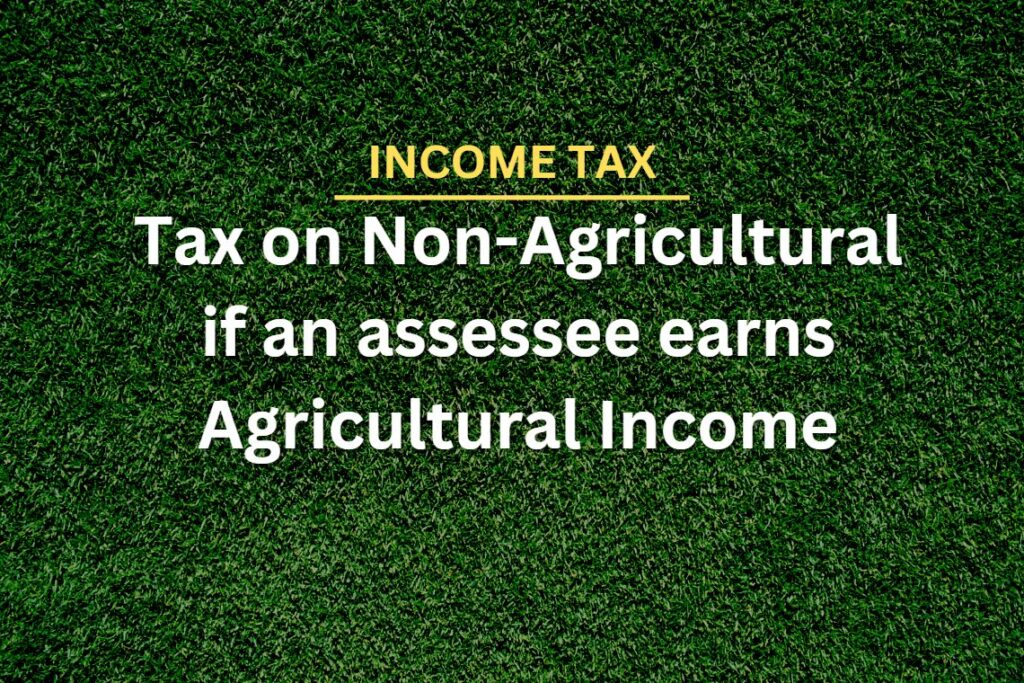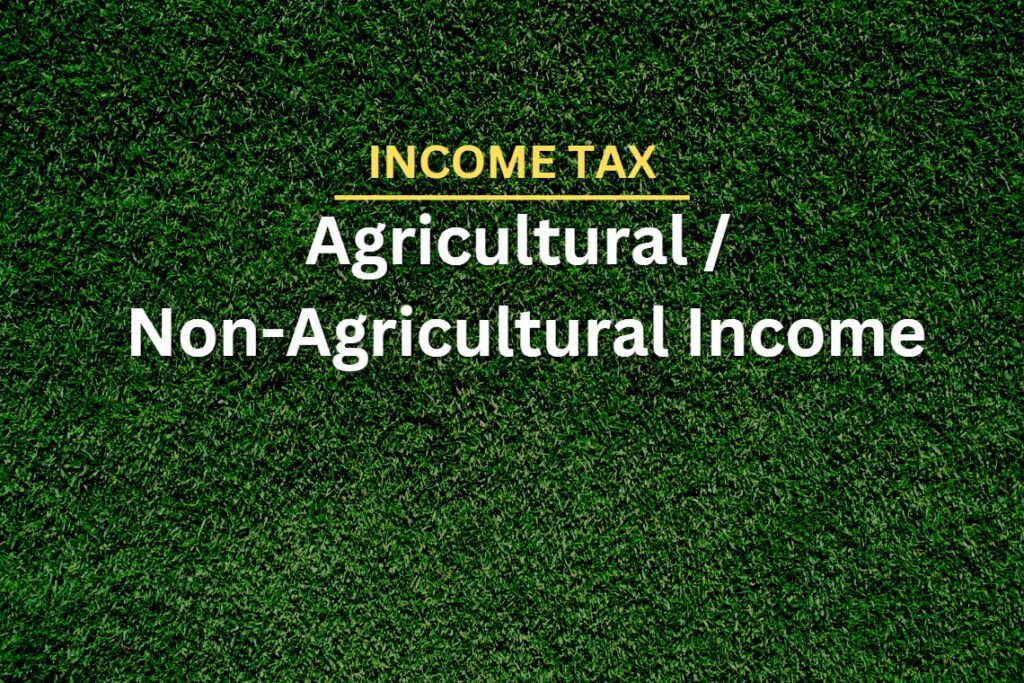Section 10(1) of the Income-tax Act, 1961 exempts agricultural income from income-tax. However, net agricultural income is added to the total non-agricultural income computed as per income-tax Act, for the purpose of determining the income-tax on non-agricultural income of an individual, HUE, AOP/BOI or an artificial juridical person, although the agricultural income will remain fully exempt.
Agricultural income including the following:
(1) any rent or revenue derived from land;
(2) any income derived from such land by agriculture or from processing of agricultural produce;
(3) any income from farm building.
The above three types of income shall be treated as ‘agricultural income’ on! when the following conditions are satisfied:
(i) Income should be derived from land.
(ii) Land should be situated in India.
(iii) Land should be used for agricultural purposes.
Income of Nursery [Explanation 3 to section 2(1A)]:
Any income derived from saplings or seedlings grown in a nursery shall be deemed to be agricultural income. Accordingly, irrespective of whether the basic operations have been earned out on land, such income will be treated as agricultural income, thus qualifying for exemption under section 10(1) of the Act.
This exemption applies to all types of nurseries, including those that grow fruit trees, ornamental plants, and flowers. It also applies to nurseries that process their produce to make it fit for market, such as by grafting, budding, or pruning.
The above Three types of agricultural incomes have been defined under Section 2(1A)(a), 2(1A)(b) and 2(1A)(c) respectively. The definition is being discussed in detail as under:
1. Rent or Revenue derived from Land [Sec. 2(1A) (a)] –
According to section 2(1A)(a), if the following three conditions are satisfied, income derived from land can be termed as “agricultural income”:
- Rent or revenue should be derived from land (may be in cash or kind);
- The land is one which is situated in India (if the land is situated in a foreign country, this condition is not satisfied); and
- The land is used for agricultural purposes.
Land Used for Agricultural Purposes –
The primary condition to claim exemption as “agricultural income” is that the land in question should be used for agricultural purposes whether exemption is sought under sub-clause (a) or (b) or (c) of section 2(1A).
The terms “agriculture” and “agricultural purposes” have not been defined in the Act; one has, therefore, to depend upon ordinary meaning and decided cases.
The following principles serve as a guide in the determination of the scope of the terms “agriculture” and “agricultural purposes”:
(1) Basic Operations –
Prior to germination, some basic operations are essential to constitute agriculture. The basic operations would involve expenditure of human skill and labour upon the land itself and not merely on the growth from the land. Some illustrative instances of basic operations are tilling of land, sowing of the seeds, planting, and similar kind of operations on the land.
(2) Subsequent Operations –
Besides the basic operations, there are certain subsequent operations which are performed after the produce sprouts from the land. Illustrative instances of subsequent operations are weeding, digging the soil around the growth, removal of undesirable undergrowths and all operations which foster the growth and preserve the same, not only from insects and pests but also from degradation from outside, tending, pruning, cutting, harvesting and rendering the produce fit for the market. Mere performance of these subsequent operations on the products of the land (where such products have not been raised on the land by the performance of the basic operations described above) would not be enough to characterise them as agricultural operations. Where, however, the subsequent operations are performed in conjunction with and in continuation of the basic operations, the subsequent operations would also constitute part of the integrated activity of agriculture.
(3) Agriculture Not merely includes Food and Grains –
Agriculture does not merely imply raising of food and grains for the consumption of men and animals; it also includes all products from the performance of basic as well as subsequent operations on land. These products, for instance, may be grain or vegetable or fruits including plantation and groves or grass or pasture for consumption of beasts or articles of luxury such as betel, coffee, tea, spices, tobacco, etc., or commercial crops like cotton, flax, jute, hemp, indigo, etc. All these are products raised from the land and the term “agriculture” cannot be confined merely to the production of food and grains products for human beings but must be understood as comprising all the products of the land which have some utility either for consumption or for trade and commercial asset would also include forest products such as timber, sal and piyasal trees, casuarina plantation, tendu leaves, horra nuts, etc.
(4) Some Connection with Land Not Sufficient –
The mere fact that an activity has some connection with or is in some way dependent on land is not sufficient to bring it within the scope of the term “agriculture”. For instance, breeding and rearing of livestock, dairy farming, cheese and butter-making and poultry farming would not by themselves be agricultural purposes.
(5) Income from Nursery Operations –
Any income derived from saplings or seedlings grown in a nursery shall be deemed to be agricultural income. Accordingly, irrespective of whether the basic operations have been carried out on land, such income is treated as agricultural income and, consequently, it is under section 10(1).
2. Income derived from Agricultural Land by Agricultural Operations [Sec. 2(1A) (b)] –
Under the Income Tax Act, 1961, income derived from agricultural land by agricultural operations is subject to certain tax treatments. Section 2(1A)(b) of the Income Tax Act defines agricultural income as income derived from any land which is used for agricultural purposes. This includes income from the sale of agricultural produce, rent or revenue derived from agricultural land, and income derived from the farmhouse.
It is important to understand the tax implications of income derived from agricultural land to ensure compliance with the Income Tax Act. Here are some key points to consider:
i. Exemption of Agricultural Income
Agricultural income is exempt from tax under the Income Tax Act. This means that income derived from agricultural land by agricultural operations is not included in the total income of the taxpayer for the purpose of calculating income tax liability.
ii. Conditions for Exemption
While agricultural income is generally exempt from tax, there are certain conditions that need to be fulfilled:
- The land should be used for agricultural purposes
- The income should be derived from agricultural operations
- The income should be directly related to agricultural land
If these conditions are not met, the income may not be considered as agricultural income and may be subject to tax.
iii. Income from Farmhouse
Income derived from a farmhouse is also considered as agricultural income if the farmhouse is situated on or in the immediate vicinity of the agricultural land and is used for agricultural purposes. However, if the farmhouse is used for non-agricultural purposes, the income derived from it may not be considered as agricultural income.
iv. Clubbing of Income
In certain cases, income derived from agricultural land may be clubbed with the income of the taxpayer or any other person. This can happen if the agricultural land is transferred by an individual to a firm or association of persons in which the individual has a substantial interest. In such cases, the income derived from the agricultural land will be included in the total income of the individual or the person to whom the land is transferred.
v. Tax Planning
Proper tax planning can help in optimizing the tax treatment of income derived from agricultural land. This can include structuring the ownership of the land, documenting the agricultural operations, and maintaining proper records of income and expenses related to agricultural activities.
3. Income from Farm Building [Sec. 2(1A) (c)] –
Bona fide annual value of house property is taxable under section 22. However, income from a house property which satisfies the following cumulative conditions would be treated as agricultural income and, consequently, it would be exempt from tax by virtue of section 10(1):
(1). The building should be occupied by the cultivator (as a landlord or as a tenant) or receiver of rent-in-kind (as a landlord);
(2). It should be on or in the immediate vicinity of land, situated in India and used for agricultural purposes;
(3). The cultivator or receiver of rent-in-kind should by reason of his connection with the agricultural land requires the building as a dwelling house or as a store house or other out-building; and
(4). The land is assessed to land revenue or local rate or, alternatively, the land (though not assessed to land revenue or local rate), is situated in a rural area†.
If all the aforesaid conditions are satisfied, income from a farm building is exempt from tax under section 2(1A)(c).
Use of building or land for any purpose other than agriculture –
Income would be exempt from tax only if land or building is used for agricultural purposes. In other words, if land or building is used for any other purposes, exemption is not available. For instance, if a farmer gives his building on rent for residential purposes, income is chargeable to tax.
Examples of farm buildings
Some examples of farm buildings that are exempt from income tax include:
- Barns
- Silos
- Stables
- Poultry sheds
- Greenhouses
- Irrigation facilities
- Storage facilities for agricultural produce
Important points
- The taxpayer must maintain proper records of the income and expenses incurred in relation to the farm building.
- The taxpayer must also maintain proper records of the use of the farm building.
- If the farm building is used for non-agricultural purposes, such as for residential or commercial purposes, then the income from the farm building will be taxable.

![Agricultural Income [Section 2(1A)]](https://incometaxmanagement.in/wp-content/uploads/2023/10/Agricultural-Income-Section-21A-1024x683.jpg)

![Tax Treatment of Income which is Partly Agricultural and Partly from Business [Rules 7,7A,7B,8]](https://incometaxmanagement.in/wp-content/uploads/2023/10/Tax-Treatment-Partly-Agricultural-and-Partly-from-Business-1024x683.jpg)
